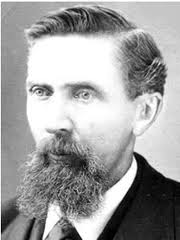 |
| MK McClintock, author |
Conrad Kohrs
Montana’s
Great Cattle Baron
by MK McClintock
author of Gallagher’s Pride
"The range cattle industry has seen its inception, zenith, and partial extinction all within a half-century. The changes of the past have been many; those of the future may be of more revolutionary character." – Conrad Kohrs
In a land of soaring mountain peaks, lush forests and abundant wildlife prevails a history rich in trappers, miners and nomads, each with their own remarkable story. The history of cattle ranching in Montana is not as old as others, but it was a beginning for what would become a long-lasting way of life for many people choosing to carve out a life in this rugged land. What was once home to millions of bison and the native peoples, became a land taken over by ranchers and farmers.
 |
| Conrad Kohrs |
Between 1862 and 1864, gold was discovered in several places in southwest Montana. Prospectors came in droves and mining camps sprung up everywhere. Soon, there were thousands of miners to feed. Cattle ranches sprouted up all over western Montana to supply mining camps with meat. Most of the cattle were trailed from Oregon...Conrad Kohrs started as a butcher boy in a camp called Grasshopper Creek. When the rush to Alder Gulch began, he followed and established a beef market there. Kohrs eventually controlled and supplied the beef for nearly every gold camp. In 1866 he purchased the Grant ranch near Deer Lodge. He became the largest cattle owner in Montana and the entire Northwest.(2)
A native of Denmark, Conrad Kohrs emigrated at the age of 15 and eventually headed west in hopes of striking it rich like so many eager young men. With only some success in Canada and California, he joined the movement into western Montana and Grasshopper Creek where he realized the opportunities for wealth were greater by feeding the miners than competing with them. It was then he established a butcher shop and traveled around the territory searching for prime beef. He had several brushes with the highwaymen who plagued the isolated roads of Montana. Determined to stop these murderous bandits, Kohrs joined a group of Virginia City vigilantes, and helped track down and hang the outlaws. By 1864, robberies in the territory had plummeted.(3) Conrad was in need of land to house his growing cattle herd and purchased the Grant ranch near Deer Lodge, Montana in 1866 for $19,200 for the land, herds, buildings and equipment.(4)
The railroad into Montana, still a territory at this time, completed in the early 1880’s which made it possible to market the cattle and the roundups began, but not without serious challenges. Because of the challenges, Stockgrowers Associations were formed, the first in 1881. They discussed the Indians, predators, diseases, legislation and outlaws. The Indians were starving and often stole cattle; the white man had killed all their bison. Wolves were destructive predators, hunting in packs and killing cows, calves and many sheep and lambs.(2)
Conrad Kohrs, one of Montana's first cattle barons and greatest pioneers, passed away in Helena, Montana in 1920.
Quick Facts:
- At age 15, he went to sea and over the next 17 years worked as a seaman, a butcher, a sausage salesman, ran log rafts down the Mississippi, and worked in a distillery.
- Born in Holstein, he became a U.S. citizen in 1857.(5)
- Sold by Kohrs grandson, The Grant-Kohrs Ranch was designated as a National Historic Landmark on December 19, 1960 to commemorate the Western cattle industry. The current park, created in 1972, is maintained as a working ranch by the National Park Service.(4)
- The 1,500-acre park/ranch includes 90 structures, 26,000 artifacts and 100 shelved feet of business records kept since Kohrs acquired the ranch in 1866.(4)
- Part of the original Grant-Kohrs Ranch, the land existing Rock Creek Cattle Company sits on was more specifically part of the Kohrs and Bielenberg Land and Livestock Company, which was sold in three large parcels after the dissolution of the Grant-Kohrs cattle empire.6
- In 2008, Conrad Kohrs was deservedly inducted into the Montana Cowboy Hall of Fame.
- Author Patricia Nell Warren is a descendant of Conrad Kohrs and lived on The Grant-Kohrs Ranch.
 |
| Conrad Kohrs in his living room |
I can’t possibly do justice to the long history of cattle ranching in Montana or Conrad Kohrs extensive contributions to it, so I do hope that readers will take the time to learn more on their own.
Did you Know?
“Range Wars” between cattlemen and sheep growers didn’t happen in Montana. For a time, Montana cattlemen found it profitable to raise sheep. Then, when cattle became profitable again, they switched back to cattle. Montana ranges support a wide variety of grazing animals, both wild and domestic.(1)
Sources:
Our thanks to MK McClintock!
Please comment to be one of the three lucky winners.
Yes, THREE will win copies of Gallagher's Hope!
Drawing will be September 15 at 9pm Pacific Time.
If you don't leave your email address, we can't contact you, so we'll have to draw another winner.



Such a pleasure to be joining you again today Jacquie!
ReplyDeleteFascinating post. Thanks for sharing.
ReplyDeletebn100candg(at)hotmail(dot)com
A very interesting life he led. I loved this thank you.
ReplyDeletemarypres(AT)gmail(DOT)com